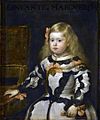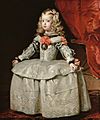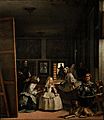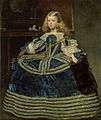Margaret Theresa of Spain facts for kids
Quick facts for kids Margaret Theresa of Spain |
|
|---|---|

Portrait from unknown author, c. 1662–1664, currently displayed in the Kunsthistorisches Museum, Vienna
|
|
| Holy Roman Empress (more...) | |
| Tenure | 25 April 1666 – 12 March 1673 |
| Born | 12 July 1651 Royal Alcazar, Madrid, Spain |
| Died | 12 March 1673 (aged 21) Hofburg Palace, Vienna, Austria |
| Burial | Imperial Crypt |
| Spouse | |
| Issue Detail |
Maria Antonia, Electress of Bavaria |
| House | Habsburg |
| Father | Philip IV of Spain |
| Mother | Mariana of Austria |
| Religion | Roman Catholicism |
Margaret Theresa of Spain (Spanish: Margarita Teresa, German: Margarete Theresia; born 12 July 1651 – died 12 March 1673) was an important princess from Spain. She became the Holy Roman Empress and German Queen by marrying Leopold I. She was also the Archduchess of Austria and Queen of Hungary and Bohemia.
Margaret Theresa was the daughter of King Philip IV of Spain. She was the older full-sister of Charles II, who was the last Spanish king from the Habsburg family. She is famous for being the main person in the painting Las Meninas by Diego Velázquez. Many of his later paintings also show her.
Contents
Biography of Margaret Theresa
Her Early Life in Spain
Margaret Theresa was born on 12 July 1651 in Madrid, Spain. She was the first child of King Philip IV of Spain and his second wife, Mariana of Austria. Mariana was also Philip IV's niece. This meant Margaret's mother was much younger than her father.
Margaret's parents married for political reasons. They wanted a new son to take over the Spanish throne. This was because Philip IV's first son, Balthasar Charles, had died young. Margaret had an older half-sister, Maria Theresa, who later married King Louis XIV of France.
After Margaret, her parents had four more children. But only one survived, her younger brother, the future King Charles II of Spain. Unlike her brother, Margaret did not have serious health problems from her parents being closely related. She was sick once as a child but got better.
People at the time said Margaret was pretty and lively. Her family called her "little angel." She grew up in the Queen's rooms in the Royal Alcazar of Madrid. She had many maids and servants. Margaret loved sweets and would hide them from her doctors. Both her father and her grandfather, Emperor Ferdinand III, loved her very much. Her father called her "my joy." Margaret was also taught well, following the strict rules of the Spanish court.
Her Betrothal and Royal Marriage
In the 1650s, the Spanish and Austrian branches of the House of Habsburg wanted to arrange another royal marriage. This was to make both countries stronger, especially against France. At first, they thought about Margaret's older half-sister, Maria Theresa. But Maria Theresa married the French King, Louis XIV of France, in 1660. She gave up her right to the Spanish throne as part of her marriage deal.
Then, discussions began about Margaret marrying Leopold I. He was her mother's brother and her father's cousin. The Spanish court was not sure about this marriage. They worried Margaret might become Queen of Spain if her younger brother died. King Philip IV also refused an idea for Margaret to marry King Charles II of England.
In October 1662, a new ambassador from Austria arrived in Spain. His main job was to arrange the marriage between Margaret and Emperor Leopold. On 6 April 1663, Margaret and Leopold I were officially engaged. The marriage contract was signed on 18 December. A new portrait of Margaret was sent to the Emperor so he could see his future wife.
King Philip IV died on 17 September 1665. He did not mention Margaret's engagement in his will. It seemed he still wasn't sure about her marrying Leopold. He wanted to make sure she could rule Spain if his male family line ended. Margaret's mother, Mariana of Austria, was now the Queen Mother and ruled for her young son, Charles II. She delayed the wedding.
The marriage finally happened after a lot of effort from Austrian diplomats. On 25 April 1666, a wedding ceremony was held in Madrid. The groom, Leopold, was not there in person. Someone stood in for him in a "marriage by proxy." The Queen Mother, King Charles II, and many nobles attended.
On 28 April 1666, Margaret left Madrid for Vienna with her own group of people. She traveled by ship and then by land. She stopped in many cities like Milan and Venice. In each place, people celebrated her arrival. On 8 October, she was officially handed over to Leopold's representatives. Finally, on 25 November, she arrived near Vienna, where the Emperor came to meet her.
Becoming Holy Roman Empress
Margaret officially entered Vienna on 5 December 1666. Her wedding ceremony took place seven days later. The celebrations in Vienna for the imperial wedding were very grand. They lasted for almost two years.
The Emperor had a huge outdoor theater built for 5,000 people. For Margaret's birthday in July 1668, a famous opera called Il pomo d'oro (The Golden Apple) was performed there. People at the time called it the "staging of the century" because it was so magnificent and expensive. The year before, the Emperor also put on a horse ballet. He rode his horse, Speranza, and it looked like the horses were flying!
Even though Leopold I was older and not considered very handsome, and Margaret had health issues, they had a happy marriage. Margaret always called her husband "Uncle," and he called her "Gretl." They both loved art and music.
During her six years of marriage, Margaret had four children. Only one child survived past infancy:
- Ferdinand Wenceslaus (born 1667 – died 1668)
- Maria Antonia (born 1669 – died 1692), who later married and had a son named Joseph Ferdinand.
- John Leopold (born and died 1670)
- Maria Anna Josepha (born and died 1672)
It is said that Margaret influenced her husband to make a decision about the Jewish community in Vienna. She believed they were connected to the deaths of her children. In 1670, during a religious celebration, the Emperor ordered the destruction of the Vienna synagogue. A church was then built on that spot.
Margaret kept her Spanish customs even after marriage. She was mostly surrounded by her Spanish staff. She loved Spanish music and dances. Because of this, she hardly learned German.
Her Death and Legacy
Margaret had many pregnancies in a short time. This weakened her health. She died on 12 March 1673, at the young age of 21. She was buried in the Imperial Crypt in Vienna.
Just four months after her death, Emperor Leopold I married again. He was sad about losing his "only Margareta," but he married Claudia Felicitas of Austria, another member of the Habsburg family.
After Margaret's death, her rights to the Spanish throne went to her only surviving daughter, Maria Antonia. When Maria Antonia died in 1692, these rights passed to her son, Prince Joseph Ferdinand of Bavaria. After Joseph Ferdinand died young in 1699, there was a big argument over who should inherit the Spanish throne. This led to a war called the War of the Spanish Succession. In the end, a new branch of the royal family, the House of Bourbon, took over the Spanish throne with King Philip V. He was Margaret's great-nephew.
Margaret Theresa in Art
The famous painter Diego Velázquez painted many portraits of Margaret Theresa. He started painting her when she was very young. From 1653 to 1659, he created a series of portraits of the Infanta. Three of these paintings are now in the Kunsthistorisches Museum in Vienna: "Infanta Margarita in a pink dress" (1660), Infanta Margarita in a silver dress (1656), and Infanta Margarita in a blue dress (1659). In his last paintings of Margaret, when she was 8 years old, she looks more grown-up and formal because of her upcoming marriage.
The most famous painting by Velázquez featuring Margaret is Las Meninas (1656). It is now in the Museo del Prado in Madrid. In this painting, Velázquez shows the 5-year-old Infanta in his studio. She is surrounded by her maids and other people from the court. Her eyes are looking at her parents, whose reflection can be seen in a mirror on the wall. This painting later inspired Pablo Picasso, who created many versions of it in 1957.
Margaret's image in Velázquez's paintings also inspired writers. The poet Boris Pasternak mentioned her in a poem from 1923. He saw her as a vision during a thunderstorm in Moscow.
The painting Infanta Margarita Teresa in a Pink Dress (1660) was once thought to be by Velázquez. But now, it is believed to be a masterpiece by his son-in-law, Juan Bautista Martínez del Mazo. Martínez del Mazo also painted "Portrait of the Infanta Margarita in mourning dress" (1666). This painting shows her shortly after her father's death and just before her wedding. Both paintings are in the Museo del Prado. There is also a "Portrait of the Infanta Margarita" (1655) in the Musée du Louvre in Paris, but experts still debate if it was painted by Velázquez.
Many European artists painted Margaret as an adult. Most of these portraits are in the Kunsthistorisches Museum in Vienna. These include "a full-length portrait of the Infanta Margarita Teresa, the Empress" (1665) by Gerard Du Chateau. Another is "Portrait of Empress Margarita Teresa in a theatrical costume" (1667) by Jan Thomas van Ieperen. One of the last portraits of Margaret is "Portrait of Empress Margarita Teresa and her daughter Maria Antonia" (1671) by Benjamin Block. This painting, now in the Hofburg Palace, shows her with her only surviving child. Many copies of her portraits exist in museums around the world.
Images for kids
-
Infanta Margarita Teresa in pink dress (1653), by Velázquez, Kunsthistorisches Museum, Vienna
-
Infanta Margarita Teresa (1655), by Velázquez, Musée du Louvre, Paris
-
Las Meninas (1656), by Velázquez, Museo del Prado, Madrid
-
Infanta Margarita Teresa in blue dress (1659), by Velázquez, Kunsthistorisches Museum, Vienna
-
Infanta Margarita Teresa in pink dress (1660) by Velázquez or Juan Bautista Martínez del Mazo, Prado Museum, Madrid
See also
 In Spanish: Margarita Teresa de Austria para niños
In Spanish: Margarita Teresa de Austria para niños









